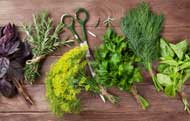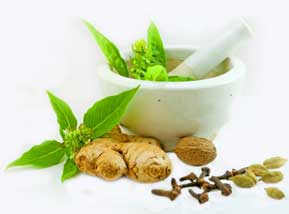




Herbs -
is a good source of

1. Herb Facts
2. Tips for Cooking and Storage
3. Types of Herbs
4. Herb Nutritional Value
5. Herb Health Benefits
2. Tips for Cooking and Storage
3. Types of Herbs
4. Herb Nutritional Value
5. Herb Health Benefits
Herbs Facts
In general use, herbs are any plants used for food, flavoring, medicine, or perfume. Culinary use typically distinguishes herbs from spices. Herbs refer to the leafy green parts of a plant (either fresh or dried), while a “spice” is a product from another part of the plant (usually dried), including seeds, berries, bark, roots and fruits.
History and Origin
Tips for Cooking and Storage
Tips for Cooking and Storage of Herbs
(coming soon)
Common Types of Herbs (Australia)
Culinary Herbs
- • Basil
- • Coriander
- • Cumin
- • Dill
- • Lemon Grass
- • Marjoram
- • Mint
- • Oregano
- • Parsley
- • Rosemary
- • Sage
- • Tarragon
- • Thyme
- • Fennel
Other Medicinal Herbs
Herbs Nutritional Value
|
Herb ” Parsley ” ( Nutritional value )
Nutritional Value per 1.6 g – 1 Tablespoon Parsley, dried |
|||||||||||||||||||||||||||||||||||||||||||||||||||||||||||||||||||||||||||||||||||||||||||||||||||||||||||||||||||||||||||||||||||||||||||||||||||||||||||||||||||||
|
|||||||||||||||||||||||||||||||||||||||||||||||||||||||||||||||||||||||||||||||||||||||||||||||||||||||||||||||||||||||||||||||||||||||||||||||||||||||||||||||||||||

|
Reference Values are based on a 2,000 Calorie Intake, for Adults and Children 4 or More Years of Age. Your daily values may be higher or lower depending on your calorie needs.
|
|
Percentages are roughly approximated using (RDA) Recommended Dietary Allowances for adults. Source: USDA United States Department of Agriculture
|
|
Reference Values for Nutrition – National Institutes of Health USA
|
Herbs Nutritional Value
Herbs Health Benefits
Herbs

HEALTH
References
|
Nutrient Database – USDA (United States Department of Agriculture)
|
|
Reference Values for Nutrition – National Institutes of Health USA
|
